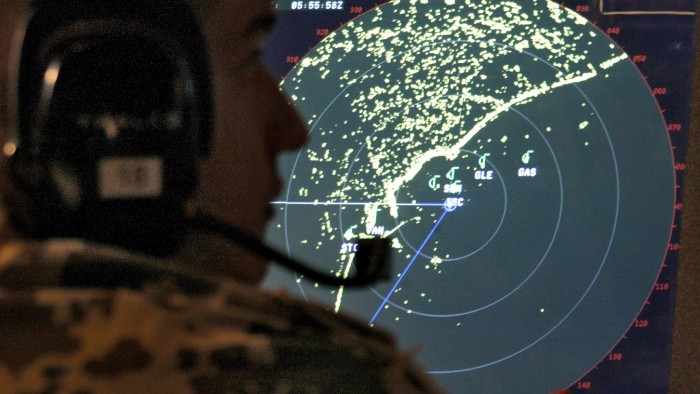Europe’s ports vulnerable as ships sail without oversight

Roula Khalaf, Editor of the FT, selects her favourite stories in this weekly newsletter.
As Europe’s politicians struggle to control a deepening migrant crisis and staunch the rising threat of Islamist terrorism on their borders, little attention is being paid to the continent’s biggest frontier: the sea.
New data highlight the extent to which smuggling, bogus shipping logs, unusual coastal stop-offs and inexplicable voyages are increasing across the Mediterranean and Atlantic for ships passing through Europe’s ports — with little or nothing being done to combat the trend.
There is currently no comprehensive system to track shipments and cargos through EU ports and along its approximately 70,000km of coastline — a deficiency that has long been exploited by organised criminals and which could increasingly prove irresistible to terrorists too, say European security officials.
“So far, the thing about maritime security, and particularly terrorists exploiting weaknesses there, is that it’s the dog that’s not barked,” says former Royal Navy captain Gerry Northwood, chief operating officer of Mast, a maritime security company, and commander of the counter-piracy task force in the Indian Ocean. “But the potential is there. The world outside Europe — North Africa for example — is awash with weapons. If you can get a bunch of AK47s into a container, embark that container from Aden then you could get them into Hamburg pretty easily. A whole armoury’s worth.”
In January, 540 cargo ships entered European ports after passing through the territorial waters of terrorist hotspots Syria and Libya, as well as Lebanon, for unclear or uneconomic reasons during the course of their voyages.
The number of vessels using flags of convenience — using the ensign of a state different to that in which a ship’s owners reside to mask identity or reduce tax bills — is also rising. Of the 9,000 ships that passed through European waters last month, 5,500 used flags of convenience.

The data were compiled for the FT by Windward, an Israeli maritime intelligence company which collates shipping data from public and proprietary sources and uses algorithms to identify unusual or suspicious activities.
Some specific cases identified in the Windward data are particularly worrisome. In the middle of last month, for example, one 76-metre cargo ship left Golcuk in Turkey, sailed to Misurata in Libya and then switched off its location and transmitting devices for three hours as it sailed close to shore along the coast of Tunisia before reassuming its stated course and going to Pozzallo in Italy.
Another ship left Genoa bound for Lisbon on November 8, but rather than take a direct route, the vessel took a 500 nautical mile detour to a point mid-sea off the coast of Africa, where it stopped, lingered, and then performed a u-turn towards Portugal. It raises the possibility that the ship performed a mid-sea rendezvous with another vessel to transfer an illicit cargo.

A senior European counter terrorism official said there was mounting concern about port and maritime security in Brussels and in Europe’s capitals, but that the scale of the problem was so large that no one was thinking of ways to meaningfully tackle it. “Some countries have pretty good customs operations, but we’re talking about having to monitor hundreds of ports and co-ordinate across them. The reality is that most of the time we are relying on what the ship’s captain is telling us,” he said.
Even a single container ship was impossible to fully search, he added.
In the wake of the September 11 terror attacks in New York and Washington, and the bombing of the Limburg oil tanker in the Gulf of Aden in 2002, maritime security standards were strengthened significantly with the International Ship and Port Security Code, an amendment to the safety of life at sea convention.
The code requires port authorities to have detailed security plans and measures in place, but it stops short of mandating specific standards. Many European states resisted stronger measures on cost grounds and enforcement is patchy, say experts.
“In principle it is stringent but in practice, it’s only as good as the people who are applying it,” says Mr Northwood. “There is very little or no oversight.”
Part of the problem in Europe is a lack of co-ordination or information sharing in identifying suspicious activity at sea that would allow authorities to target their investigative resources more effectively.

“What’s needed is better upstream intelligence,” says Calum Jeffray, research fellow at the defence think-tank RUSI. “There is thematic analysis across Europe, but a lot of that is specifically around narcotics . . . there’s a tendency to overlook maritime and port security when it comes to terrorism. When you think about how much effort goes into airport screening — there’s a huge difference. And what is happening in north Africa at the moment is going to make that much more noticeable.”
Mr Jeffray suggested that oversight could be improved by expanding the remit of the maritime analysis and operations centre (MOAC), a Portugal-based multilateral naval intelligence service staffed by military officials from seven EU states and the US. The centre currently only has a remit to interdict narcotics smuggling.
“Something more is needed,” says Ami Daniel, chief executive of Windward. “At the moment, the sea is a backdoor into Europe and unless there is clear intelligence or a tip off, most of these vessels are never inspected or intercepted. We are getting to a point where this is going to cause problems . . . arms, drugs and people are all coming over unchecked.”

Letter in response to this report:
Welfare of seafarers is important to security / From John Green
Comments